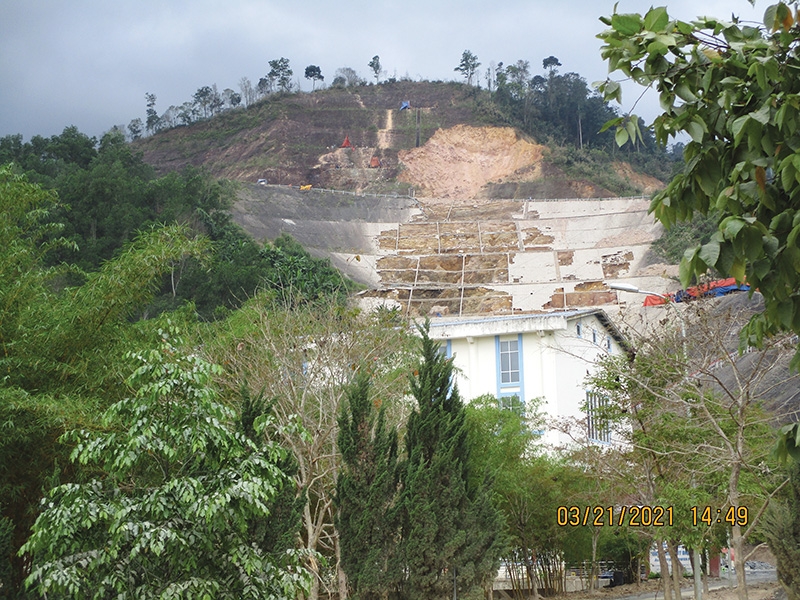Deforestation past continuing to haunt erosion-hit areas
 |
| After a typhoon in November, the A Luoi hydropower plant was damaged by a landslide, stopping its operations, Photo: Dr. Greg Nagle |
Dr. Greg Nagle took several eye-opening photographs during his March 21 trip near the National Road No.49 between A Luoi and Hong Ha areas. “I think that this is unusually erosive terrain here,” commented Dr. Nagle, adding that “most often, the worst erosion comes from logging and roads changing hill slope hydrology.”
However, some of the visible erosion in the area could also be the result of deforestation by Agent Orange over 50 years ago, or by bombs as there are also landslides in some areas which were not directly impacted by roads or logging, he added.
Although the war ended nearly half a century ago, the footprints of the war in some of Vietnam’s areas remain visible today. The rural district of A Luoi was one of the places that saw some of the heaviest fighting and bombing. The area around the infamous Hamburger Hill was the theatre of massive US bombing with the A Luoi valley hit with spray runs with Agent Blue, Agent White, and Agent Orange, as research by David Biggs portrayed.
However, the war is not the only reason for deforestation in Vietnam and wider Southeast Asia, which saw its forest cover fall from 66 to 49 per cent between 1960 and 1990, as research by Rodolphe De Koninck pointed out. As Vietnam was the country that lost most of its forest cover during this period, social and economic consequences for farmers greatly increased as they tried to support their livelihoods.
Other studies have shown that deforestation in Southeast Asia has not occurred because of a single factor, but instead a host of economic and ecological causes.
For instance in 2000, Vietnam started a massive programme around the country to grow hybrid Acacia mangium, an evergreen fast-growing tropical tree which is now one of the country’s main exports for wood for chips and in the manufacturing of furniture, offering a serious cash flow for remote mountain communities. “These trees are grown in about five years and are small enough to be mostly harvested and moved by hand in many places,” explained Nagle.
However, some scientists have pointed out that inappropriate management practices can cause soil erosion in the area. “A number of current practices have the potential to degrade these sites in several ways,” said Sadanandan E.K. Nambiar from the The Commonwealth Scientific and Industrial Research Organisation in a paper with two other scientists. They also argued that a “number of current practices have the potential to degrade these sites in several ways.”
After harvest, tops and branches may be removed for fuel and the remaining biomass burned, which exposes the soil. Together with bulldozing and windrowing operations, the bare soil surface is exposed to rains, leading to serious soil erosion.
Nagle explained, “Some of what we are seeing here is serious soil damage with a loss in long-term productivity.” Forestry cannot be sustained with such damage, he added. “This is some of the worst forestry-related erosion I have ever seen anywhere in the world, although there were places as bad as this on very erosive soils in the Redwood region of northern California which were logged in the 1950s-1970s.”
Although there is a multitude of reasons for the area’s soil erosion and not a single action or entity to blame for, the pictures taken a fortnight ago show that the soil condition poses serious challenges to the local populace and economy.
Local media reported last October and November that several national highways in Central Vietnam were ravaged by landslides, which also destroyed parts of the National Road No.49 running through Thua Thien-Hue.
In an interview in November, Trinh Xuan Hoa, deputy head of the Vietnam Institute of Geosciences and Mineral Resources under the Ministry of Natural Resources and Environment, argued that deforestation and construction projects among many other factors were the cause of the landslides in the region. “Human activities including deforestation and road construction have hastened geological changes in the area,” he explained.
What the stars mean:
★ Poor ★ ★ Promising ★★★ Good ★★★★ Very good ★★★★★ Exceptional
Themes: Climate Change Response
Related Contents
Latest News
More News
- Heavy industries set for pilot greenhouse gas quotas (December 25, 2025 | 10:00)
- Swedfund invests in MSME growth and climate action in Vietnam (December 19, 2025 | 11:42)
- GreenYellow brings solar energy to light up remote schools in Tuyen Quang province (December 19, 2025 | 08:00)
- Charge+, Grab partner to develop EV charging network in Vietnam (December 18, 2025 | 17:11)
- Linking sci-tech and innovation to Vietnam’s net-zero future (December 18, 2025 | 14:31)
- Driving double-digit growth through green and circular transformation in Vietnam (December 17, 2025 | 09:00)
- Standard Chartered and ACCA deepen collaboration to develop Vietnam’s talent for a sustainable future (December 15, 2025 | 18:18)
- Schaeffler reports strong early output from Dong Nai solar project (December 12, 2025 | 15:16)
- Forestry conference highlights biodiversity and sustainability goals (December 09, 2025 | 13:35)
- Home Credit honoured among top 10 sustainable companies in trade and services (December 09, 2025 | 12:18)

 Tag:
Tag:





















 Mobile Version
Mobile Version